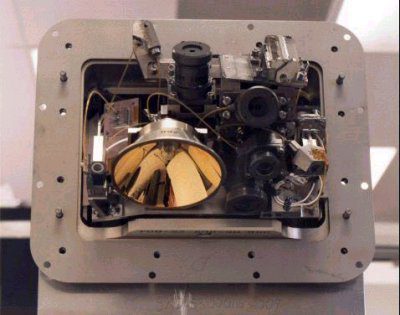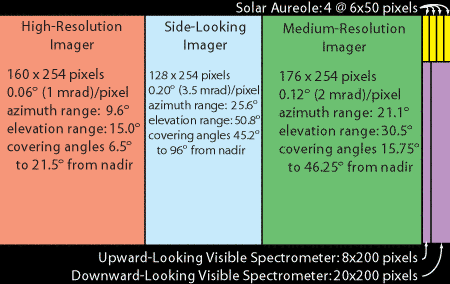Amir Alexander • Jan 10, 2005
Descent Imager Spectral Radiometer (DISR)
Optical Remote Sensing Instrument for the Huygens Probe
• Scientific Objectives
• How it Works
• Saturn Exploration Context
• Camera Facts
• Example Data
• The Science Team
Scientific Objectives
To study Titan's atmosphere:
• To study the thermal balance of the atmosphere by measuring the absorption of sunlight as a function of altitude
• To study the distribution and properties of aerosol and cloud particles
• To study the nature and distribution of photochemical haze layers
• To study the composition of the atmosphere, in particular the mixing ratio of methane as a function of altitude
• To measure horizontal wind speeds
To study Titan's surface and its interaction with the atmosphere:
• To capture 700 images of the surface at resolutions varying from 150 meters to less than 1 meter per pixel, and assemble these into 20 panoramic mosaics of the surface as seen from altitudes varying from 150 km to a few hundred meters.
• To measure reflection spectra of the surface at several thousand locations.
How it Works

The Descent Imager Spectral Radiometer crams six sub-instruments into a tiny footprint within the Huygens probe. The component instruments on DISR share space on one Charged Coupled Device (CCD, the most common kind of detector in digital cameras) and two linear indium-gallium-arsenic arrays (commonly used for spectrometry). The light that is gathered by DISR's optics is shared among all the instruments and the detectors through an ingenious system of bundled fiber optic ribbons, so DISR has almost no moving parts.
There are six sub-instruments:
• Imagers: In order to take maximum advantage of the limited data rate available to DISR, the imaging system is split into three cameras: a low-resolution, Side-Looking imager (SLI); a Medium-Resolution imager (MRI) pointed at an angle, and a High-Resolution Imager (HRI) pointed downward. There is no color information in the camera images.
• Visible Spectrometer: There are two, an Upward-Looking Visible Spectrometer (ULVS) and a Downward-Looking Visible Spectrometer (DLVS), which allow DISR to measure the spectral properties of the sunlight that streams downward from the Sun (using ULVS) and the reflected light streaming upward from Titan (using DLVS). The DLVS can resolve 4 by 4-degree pixels on the ground. The DISR team will use data from the Visible Spectrometers to apply color to the camera images.
• Infrared Spectrometer: Also split into an upward-looking and a downward-looking instrument, the Infrared Spectrometer extends the color information gathered by DISR into near-infrared wavelengths (870 to 1700 nm).
• Solar Aureole Camera: Measures the intensity of scattered sunlight in the atmosphere in order to determine the size and shape of particles in the atmosphere.
• Violet Photometer: There are two, one upward- and one downward-looking violet photometer. They measures the intensity of light in an area of the spectrum (violet light at 350 nm wavelength) that is sensitive to the presence of photochemical hazes.
• Sun Sensor: As Huygens rotates, this instrument tracks the direction toward the Sun, in order to trigger the upward-looking instruments to capture data at known orientations relative to the position of the Sun.
In addition to the six sub-instruments, DISR also sports a "Surface Science Lamp," which is activated when Huygens is at an elevation of 700 meters above the ground to provide a light source for the downward-looking instruments.
Each of the three imagers is alotted an individual chunk of the space on the DISR CCD:

The resolutions and areal coverages of the three cameras were chosen to maximize the area of Titan's surface that could be observed in one "look," while also maximizing the resolution of the downward-pointing view. The three cameras have slightly overlapping footprints on the ground:
At any one azimuth, Huygens captures a "triplet" of images, one from each camera:

How Does the Descent Imager Spectral Radiometer Fit in the Context of Planetary Exploration?
Since there has never been a mission like Huygens, there has never been a camera system like DISR. No spacecraft has ever had to capture and return all of its images within 2.5 hours while descending toward a surface on a spinning, swaying platform. On top of these geometric challenges, DISR was limited to a data rate of 4800 bits per second. Surface missions to Mars had the luxury of months to years to return images. The only other missions that faced anything near the engineering challenges that Huygens faced were the Venera landers, the Soviet missions to the surface of Venus. Those landers returned only one to four images apiece; Huygens returned more than 350.
The highest-elevation (and consequently lowest-resolution) images captured by DISR should overlap the highest-resolution images achievable by the ISS (camera) and VIMS instruments on Cassini, so the images and spectral readings captured by DISR should provide invaluable "ground truth" information for the global mapping products obtained by the Cassini instruments.
DISR Facts
These facts focus on the imaging sub-instrument of DISR. For further information on the DISR system, check out M. G. Tomasko et al., "The Descent Imager/Spectral Radiometer (DISR) Experiment on the Huygens Entry Probe of Titan," Space Science Reviews 104: 469-551, 2002.
High-Resolution Imager (HRI) | Medium-Resolution Imager (MRI) | Side-Looking Imager (SLI) | |
| Image size | 160 x 254 pixels | 176 x 254 pixels | 128 x 254 pixels |
| Field of view | 9.6° (azimuth) x 15.0° (elevation) | 21.1° (azimuth) x 30.5° (elevation) | 25.6° (azimuth) x 50.8° (elevation) |
| Nadir range | 6.5° to 21.5° | 15.75° to 46.25° | 45.2° to 96° |
| Angular resolution | 0.06° (1 millirad) | 0.12° (2 millirad) | 0.20° (3.5 millirad) |
| Spectral range | Broadband, 660–1000 nm (red and near-infrared wavelengths | ||
Imaging Plan
In order to make the most of the 2.5-hour descent and 4800 bits/second bandwidth available to the DISR system, different kinds of observations were employed at different elevations above Titan's surface.
| Elevation | Plan |
| 170 km | DISR powered on The highest possible spatial resolution of the HRI is 170 m/pixel. Huygens is spinning roughly 6-8 times per minute. |
| 160–20 km | DISR alternates between "Imaging Cycles," in which one SLI-MRI-HRI triplet of images is taken each time Huygens rotates 30 degrees, and "Non-Imaging Cycles," in which only spectral measurements are taken. Alternate Imaging Cycles are offset by 15 degrees, so that alternate sets fill in the gaps between side-looking images. (Offsets of 30 degrees capture enough image information for a continuous mosaic of HRI and MRI images, but leave large gaps between SLI images.) Four times during this part of the descent, DISR pauses to calibrate its detectors using onboard calibration lamps. The calibrations take place when the instrument passes through predetermined temperatures. The rotation rate increases to as much as 10 rotations per minute at an altitude of 85 km, but slows down to only 1 or 2 rotations per minute at an altitude of 20 km. |
| 20 km | The DISR buffer is emptied to prepare for highest-resolution surface imaging. Imaging cycles repeat every time enough space is available in DISR's buffer to store a new cycle of images. |
| 9 km | Imaging is paused for "Spectrophotometric Cycles," during which the downward-looking spectral instruments gather spectra as rapidly as possible for one probe rotation. The data gathered will be used to create a high-resolution spectral map of the surface. |
| 9–4 km | Imaging Cycles resume |
| 4 km | Spectrophotometric Cycle |
| 4–3 km | Imaging Cycles |
| 3 km–500 m | If normal image cycles were continued below 3 km, the data would not all be returned before surface impact, so image triplets are obtained as rapidly as possible regardless of azimuth. |
| 700 m | Surface Science Lamp turned one |
| 500–250 m | Single HRI images are obtained as rapidly as the telemetry rate permits (roughly every 8 seconds). In the last image near 250 m elevation, the HRI will achieve a resolution close to 25 cm/pixel. |
| 250–0 m | Only downward-looking spectral measurements are obtained, roughly 19 spectra |
| 0 m, after impact | First, a set of 10 upward- and downward-looking spectra are obtained. Then DISR alternates between image triplets and spectral measurements. Two minutes after impact, the Surface Science Lamp is switched off. Then it is alternately switched on and off every two minutes. |

The Science Team
The DISR science team consists of the Principal Investigator and nine Co-Investigators spread across the United States and Europe, plus many other staff engineers and scientists not listed here.
 Martin Tomasko, Lunar and Planetary Laboratory, University of Arizona, Tucson
Martin Tomasko, Lunar and Planetary Laboratory, University of Arizona, Tucson
Co-Investigators
 Lyn Doose, Lunar and Planetary Laboratory, University of Arizona, Tucson
Lyn Doose, Lunar and Planetary Laboratory, University of Arizona, Tucson
 Bashar Rizk, Lunar and Planetary Laboratory, University of Arizona, Tucson
Bashar Rizk, Lunar and Planetary Laboratory, University of Arizona, Tucson
 Peter Smith, Lunar and Planetary Laboratory, University of Arizona, Tucson
Peter Smith, Lunar and Planetary Laboratory, University of Arizona, Tucson
 Horst-Uwe Keller, Max-Planck-Institut für Aeronomie, Lindau, Germany
Horst-Uwe Keller, Max-Planck-Institut für Aeronomie, Lindau, Germany
 Athena Coustenis, l'Observatoire de Paris, France
Athena Coustenis, l'Observatoire de Paris, France
 Bernard Schmitt, l'Observatoire de Paris, France
Bernard Schmitt, l'Observatoire de Paris, France
 Bruno Bezard, l'Observatoire de Paris, France
Bruno Bezard, l'Observatoire de Paris, France
 Larry Soderblom, United States Geological Survey, Flagstaff, Arizona
Larry Soderblom, United States Geological Survey, Flagstaff, Arizona
 Robert West, Jet Propulsion Laboratory, Pasadena, California
Robert West, Jet Propulsion Laboratory, Pasadena, California
The technical information on this page comes mostly from "The Descent Imager/Spectral Radiometer (DISR) Experiment on the Huygens Entry Probe of Titan," Space Science Reviews 104: 469-551, 2002. Additional information came from the DISR team website at: http://www.lpl.arizona.edu/~kholso
Let’s Go Beyond The Horizon
Every success in space exploration is the result of the community of space enthusiasts, like you, who believe it is important. You can help usher in the next great era of space exploration with your gift today.
Donate Today

 Explore Worlds
Explore Worlds Find Life
Find Life Defend Earth
Defend Earth


